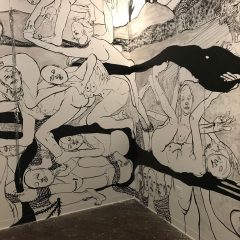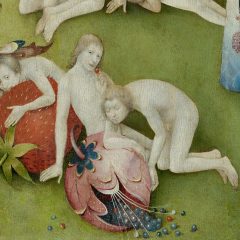For director Pieter van Huystee and the team of Dutch art historians and conservators that his documentary film follows, the devil is in the details. Rather than focus on the life of Hieronymus Bosch (d. 1516), about whom little is known, Huystee’s film is a museum “procedural,” like “Law and Order” or “CSI.” The drama comes mostly from the paintings themselves with their minutely detailed compositions and inventive creatures. The life-and-death drama of Bosch’s paintings stands in sharp contrast to the monochrome and buttoned-up world of art historians, conservators, and curators (almost all of whom are male), who are shown poring over the paintings and politely meeting with one another to discuss the possibility of loans for a blockbuster exhibition celebrating the 500th anniversary of Bosch’s birth. Cultural tensions and intellectual disagreements behind the scenes hint at the drama of academic and museum politics, but never disrupt the placid surface of the film.
For viewers who know and love Bosch’s work, this film will inspire both terror and delight as you watch museum professionals moving these paintings around, turning them over and handling them much like doctors do their patients, minutely studying the symptoms of artistic genius. But for viewers less invested in traditional art-historical concerns about dating and attribution, the film leaves you wondering, what makes a Bosch, a Bosch? Where is this elusive hand of the master, and what does it even mean? And finally, what role do national museums–and national identity–play in our access to and appreciation of these works of art?
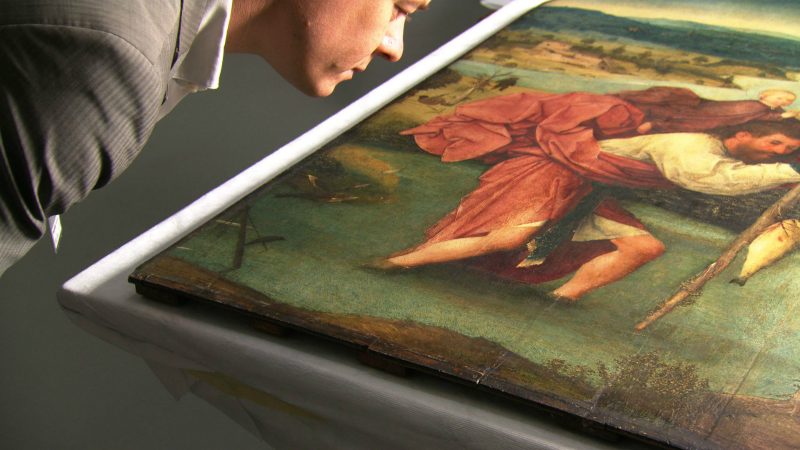
Close looking
Honing in on the small body of work left to us by Hieronymus Bosch (some 25 paintings in museums across the world), the film opens with a series of luscious details of paint. Although cracking with age, the surface of the paintings still bears witness to the agile brush and even more agile mind of the artist. Lovingly detailed brushwork brings an almost jewel-like precision to the perverse devils and monsters that populate Bosch’s paintings, their forms dissolving into abstractions of color, line, and shape through the magnifying lens of the camera. The film is a paean to close looking, the sort of slow and deep observation that so few people seem to engage in–after all, the average museum visitor spends about 15–30 seconds looking at a work of art.
One way to encourage close looking is through the use of technology–something old suddenly becomes interesting when it comes into contact with new technology. While technological tools can serve many research purposes, the film depicts the use of, for example, infrared photography and dendrochronology as a kind of “CSI: Museum Edition.” Moreover, these fancy new techniques are put in the service of the most old-fashioned questions of dating and attribution–when was the painting made, and can we identify the individual hand of Bosch himself, the great genius? These questions are crucial, without a doubt, but are they the only, or even the most important, questions that we should be asking of these paintings?
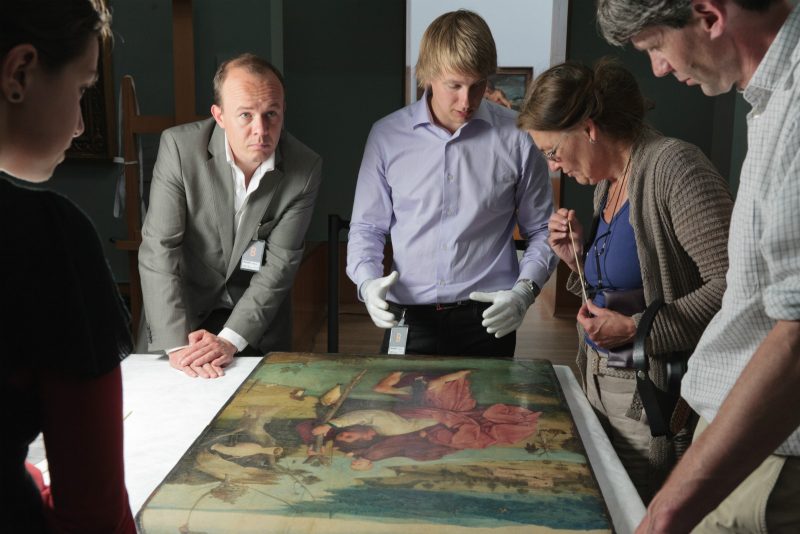
From Bosch to el Bosco
The film follows the attempts of a team of museum professionals from Bosch’s hometown, ‘s-Hertogenbosch (known as Den Bosch), as they attempt to organize a major exhibition of their most famous local son’s work. The film travels with them from the Netherlands to Spain, whose Prado Museum has the world’s largest collection of Bosch paintings–most of them in a single room. Having lived in Madrid, I know the Bosch room of the Prado very well, and having worked with Spanish government agencies, I know more than I would like to about the frustrations of negotiating with bureaucracy for access to works of art. While the Dutch art historians had my deepest sympathy when they could not negotiate all of their desired loans from Spain, the Prado’s somewhat intransigent attitude towards the scientific analysis and loan of some of its paintings to the North Brabant Museum was understandable. After all, Bosch, known as el Bosco in Spanish, is practically a Spanish artist, having been in the royal collections of the Hapsburg monarchs since the sixteenth century. Moreover, the Dutch team’s single-minded focus on identifying certain paintings as being by the singular hand of the master, versus the multiple hands of the workshop, would not endear it to museums like the Prado who rely on the star power of artists like Bosch to bring in millions of visitors each year.
Whether it’s good or bad that museums rely on big name artists to pull in visitors is a topic for debate–but it remains a fact that they very much do. And when works previously attributed to the hand of the master get “downgraded” to the products of a workshop or follower, it sends ripples through the art world.
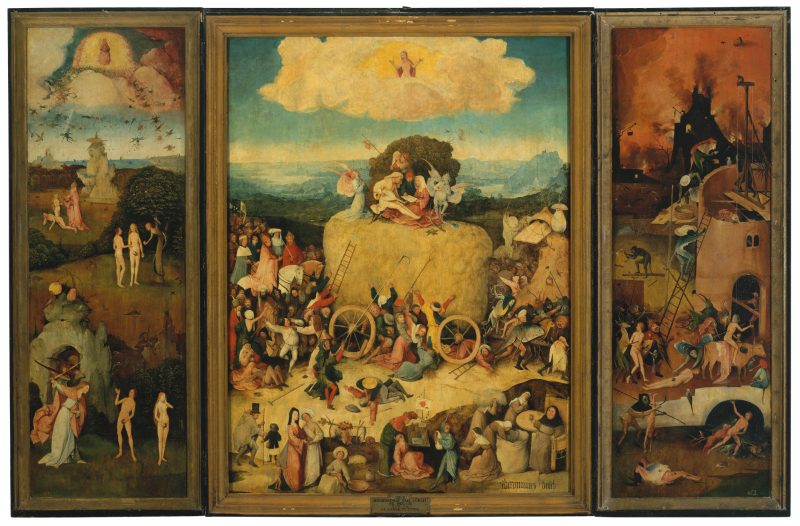
After all the political maneuvering involved in organizing an exhibition with multiple high-profile international loans, the film leaves the viewer in suspense–will the plucky art historians of Den Bosch get the loans they want? Will the Spanish cooperate with the Dutch? Will the Italians cooperate with the Spanish? These questions–which are not answered in the movie–were rendered moot after the opening of the exhibition Hieronymus Bosch: Visions of Genius at the North Brabant Museum in February of 2016, which did not include all of the paintings featured in the film. The movie ends before the exhibition took place and does not include footage of the show.
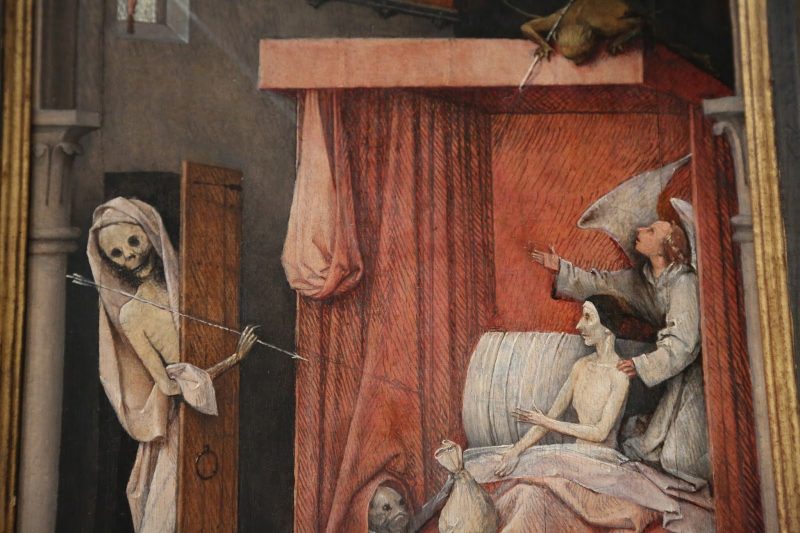
The afterlife of the artist
One of the paintings that the film spends time with, but which did not make it to the Netherlands was the National Gallery of Art’s “Death and the Miser.” This tall, narrow panel painting depicts an elderly man on the verge of death confronted with a moral quandary–cling fast to his money even when faced with Death himself, or listen to the good angel at his shoulder, who encourages him to change his ways at the last minute and have a chance at salvation. In the finished painting, the Miser seems to let go of his worldly wealth, stretching out his open hands and looking Death in the eyes. Examining the underdrawing, however, it appears that the artist changed his mind at the last minute. Underneath the paint, the Miser clings tightly to the bag of money in his right hand, even as he offers a gift to Death in his left hand. (To see the underdrawing, check out the Bosch Project’s website).
The lesson I took from this is that Bosch’s identity as an artist is as layered as the paintings themselves, shifting and slippery and hard to pin down. Indeed, it’s this very ambiguity that makes his work so vivid and compelling hundreds of years after the moral universe of the Middle Ages has faded into the distant past. Just as Bosch cannot be totally explained by the criteria of his own day, we should be skeptical about attempts to understand his work exclusively in twenty-first century terms and technologies. Pieter van Huystee’s film offers glimpses of the visual bounty of Bosch’s world even as it suggests the limitations of our own attempts to understand it. Mostly, it offers a window onto the professional world of art historians and curators, whose attempts to bring Bosch’s work to life are frustrated both by the limitations of their academic perspective as well as the pragmatic realities of red tape, marketing, and the lack of funding for the arts.
[Editor’s note – Flora reviewed a theater performance inspired by Bosch’s work back in May, 2016.]
Hieronymus Bosch: Touched by the Devil is playing from August 12–18 at Landmark’s Ritz at the Bourse Cinema, 400 Ranstead Street, Philadelphia, PA 19106.


